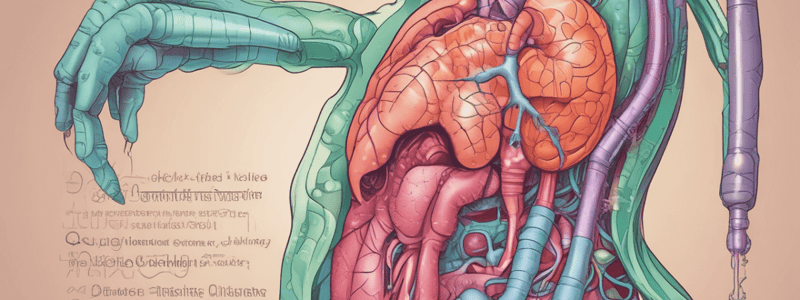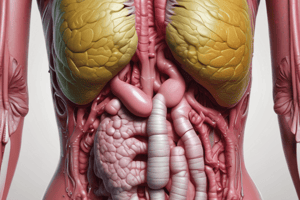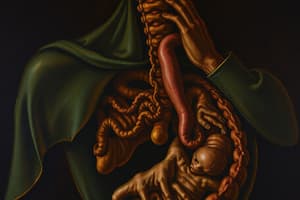Podcast
Questions and Answers
What is the term for the lack of desire to eat?
What is the term for the lack of desire to eat?
- Vomiting
- Constipation
- Anorexia (correct)
- Nausea
What is the term for the forceful emptying of stomach and intestinal contents?
What is the term for the forceful emptying of stomach and intestinal contents?
- Diarrhea
- Vomiting (correct)
- Retching
- Nausea
What is the term for the reverse movement of the stomach and esophagus without vomiting?
What is the term for the reverse movement of the stomach and esophagus without vomiting?
- Retching (correct)
- Nausea
- Constipation
- Projectile vomiting
What is the term for the infrequent or difficult defecation?
What is the term for the infrequent or difficult defecation?
What is the term for the increased frequency of bowel movements?
What is the term for the increased frequency of bowel movements?
What is the term for the pain felt between the chest and groin?
What is the term for the pain felt between the chest and groin?
What is the term for the difficulty swallowing?
What is the term for the difficulty swallowing?
What is the term for the increase in muscle tone due to nerve damage?
What is the term for the increase in muscle tone due to nerve damage?
What is the term for the condition where stomach acid repeatedly flows back into the esophagus?
What is the term for the condition where stomach acid repeatedly flows back into the esophagus?
What is the term for the change in the normal appearance of cells in the esophagus?
What is the term for the change in the normal appearance of cells in the esophagus?
What occurs when the upper part of the stomach pushes up into the chest through a small opening in the diaphragm?
What occurs when the upper part of the stomach pushes up into the chest through a small opening in the diaphragm?
What is the most common type of hiatal hernia?
What is the most common type of hiatal hernia?
What is the main cause of chronic gastritis?
What is the main cause of chronic gastritis?
What is the most common symptom of Peptic Ulcer Disease?
What is the most common symptom of Peptic Ulcer Disease?
What is the most common type of inflammatory bowel disease that affects only the colon?
What is the most common type of inflammatory bowel disease that affects only the colon?
What is the term for the feeling of needing to have a bowel movement but being unable to do so?
What is the term for the feeling of needing to have a bowel movement but being unable to do so?
What is the most common form of Crohn disease?
What is the most common form of Crohn disease?
What is the term for the narrowing of the opening from the stomach to the intestines?
What is the term for the narrowing of the opening from the stomach to the intestines?
What is the term for the thickening or swelling of the pylorus?
What is the term for the thickening or swelling of the pylorus?
What is the most common cause of intestinal obstruction in children?
What is the most common cause of intestinal obstruction in children?
What is the main location affected by ileocolitis?
What is the main location affected by ileocolitis?
What is the name of the condition where small defects in the muscle of the wall of the large intestine allow small pockets to form?
What is the name of the condition where small defects in the muscle of the wall of the large intestine allow small pockets to form?
What is the usual cause of pain in the lower right abdomen that begins around the belly button and then moves?
What is the usual cause of pain in the lower right abdomen that begins around the belly button and then moves?
What is the term for the yellowing of skin and eyes due to abnormally high levels of bilirubin?
What is the term for the yellowing of skin and eyes due to abnormally high levels of bilirubin?
What is the term for the inflammation of the bile ducts that causes inflammation of the liver and slows the flow of bile to the gut?
What is the term for the inflammation of the bile ducts that causes inflammation of the liver and slows the flow of bile to the gut?
What is the term for the inflammation of the pancreas?
What is the term for the inflammation of the pancreas?
What is the genetic disorder that causes problems with sweat glands and mucus glands?
What is the genetic disorder that causes problems with sweat glands and mucus glands?
What is the term for the blockage in the lining of the appendix that leads to bacterial multiplication and pus?
What is the term for the blockage in the lining of the appendix that leads to bacterial multiplication and pus?
What is the term for the condition where the flow of bile is stopped or reduced?
What is the term for the condition where the flow of bile is stopped or reduced?
What is the term for the inflammation of the gallbladder that can be caused by gallstones?
What is the term for the inflammation of the gallbladder that can be caused by gallstones?
What is the primary treatment for infants under two years old with cystic fibrosis?
What is the primary treatment for infants under two years old with cystic fibrosis?
What is a possible cause of stomach cancer?
What is a possible cause of stomach cancer?
In which part of the colon is blood in stool a common symptom?
In which part of the colon is blood in stool a common symptom?
What is the name of the movie that features teenagers with cystic fibrosis?
What is the name of the movie that features teenagers with cystic fibrosis?
What is the primary risk factor for esophagus cancer?
What is the primary risk factor for esophagus cancer?
In which part of the stomach is cancer often found?
In which part of the stomach is cancer often found?
What is the difference in risk of stomach cancer between males and females?
What is the difference in risk of stomach cancer between males and females?
What is the primary symptom of ascending colon cancer?
What is the primary symptom of ascending colon cancer?
What is the name of the singer who recently died from stomach cancer?
What is the name of the singer who recently died from stomach cancer?
What is the most common location of colon and rectum cancer?
What is the most common location of colon and rectum cancer?
Flashcards are hidden until you start studying
Study Notes
Pancreatic Enzyme Replacement Therapy (PERT)
- Treatment for patients with cystic fibrosis, especially infants under two years old
- No cure, but available treatments include antibiotics, anti-inflammatory drugs, oral pancreatic enzymes for digestion, mucus thinning drugs, percussion, and postural drainage
Digestive System Cancers
- Esophagus:
- Relatively rare
- Ulcerations due to reflux, chronic exposure to irritants, inadequate nutrition
- Stomach:
- Possible cause: Helicobacter pylori infection, heavy use of salts and nitrates, low intake of fruits and vegetables, alcohol and tobacco use
- Often found in pyloric portion of stomach
- Colon and Rectum:
- Signs and symptoms differ depending on location of cancer
- Ascending colon: pain, mass, change in bowel habits, anemia
- Descending colon: pain, change in bowel habits, bright red blood in stool, obstruction
- Transverse colon: pain, obstruction, change in bowel habits, anemia
- Rectum (most common): blood in stool, change in bowel habits, rectal discomfort
- Signs and symptoms differ depending on location of cancer
Clinical Manifestations of GI Dysfunction
- Anorexia: lack of desire to eat
- Vomiting: forceful emptying of stomach and intestinal contents (chyme)
- Retching: reverse movement (retro peristalsis) of stomach and esophagus without vomiting
- Projectile vomiting: not preceded by nausea or retching
- Nausea: hypersalivation and tachycardia are the most commonly associated symptoms
- Constipation: infrequent or difficult defecation
- Diarrhea: increased frequency of bowel movements
- Abdominal pain: pain felt between chest and groin
- GI bleeding: blood often shows up in stool or vomit, but isn't always obvious
Disorders of Motility
- Dysphagia: difficulty swallowing
- Two types:
- Mechanical obstruction (tumors, diverticular herniations)
- Functional obstructions (neural or muscular)
- Two types:
- Achalasia: increase in muscle tone due to nerve damage
- Also called cardiospasm
- The lower esophageal sphincter won’t relax
- Gastroesophageal reflux disease (GERD):
- Occurs when stomach acid repeatedly flows back into the esophagus
- Can trigger Barritt’s esophagus, a change in the normal appearance of cells
- Hiatal Hernia:
- Occurs when the upper part of the stomach pushes up into the chest through a small opening in the diaphragm
- Results in retention of acid and other contents since the stomach tends to get squeezed by this opening in the diaphragm
- Pyloric obstruction or gastric outlet obstruction:
- Caused by intrinsic or extrinsic mechanical blockage of gastric emptying
- Symptoms: nausea, vomiting, abdominal pain, and early satiety
- Pyloric stenosis or infantile hypertrophic pyloric stenosis:
- Thickening or swelling of the pylorus that causes severe and forceful vomiting in the first few months of life
- Enlargement of the pylorus causes a narrowing (stenosis) of the opening from the stomach to the intestines, blocking stomach contents from moving into the intestine
- Intestinal obstruction:
- Blockage that keeps food or liquid from passing through the small intestine or colon
- Symptoms: pain, loss of appetite, constipation, vomiting
- Gastritis:
- Inflammation of stomach lining caused by infection, alcohol, some medicines, smoking, some immune conditions, and allergy
- Can be acute or chronic
- Peptic Ulcer Disease:
- Most common symptom: burning stomach pain
- Severe symptoms: vomiting blood, blood in stool, trouble breathing, fainting, nausea, unexplained weight loss, appetite changes
- Duodenal ulcers occur in duodenum
- Gastric (stomach) ulcers occur in stomach
Inflammatory Bowel Diseases (IBD)
- Ulcerative colitis:
- One of the most common types of IBD
- Chronic condition due to inflammation in colon
- Includes flare-ups and remissions
- Signs and symptoms: diarrhea, bloody stools, abdominal cramping, weight loss, and tenesmus (feel like need to poop but can’t)
- Crohn disease:
- Inflammatory bowel disease that causes chronic inflammation of the entire gastrointestinal tract
- Can affect the entire thickness of the bowel wall
- Inflammation of the intestine can “skip,” or leave normal areas in between patches of diseased intestine
- Ileocolitis: affects the end of the small intestine and the beginning of the colon
- Ileitis: affects only the ileum
Diverticular Disease of Colon
- Diverticulosis: small defects in the muscle of the wall of the large intestine or colon allow small pockets or pouches (diverticula) to form
- Diverticulitis: infection or inflammation of these abnormal pouches
Acute Appendicitis
- Inflammation of the appendix
- Caused by blockage in the lining of the appendix, followed by bacterial multiplication, pus, and possible rupture
- Symptoms: pain in the lower right abdomen that usually begins around the belly button and then moves
- Nausea and vomiting, loss of appetite, low fever are also signs
Ascites
- Excess fluid in abdomen usually caused by liver cirrhosis
- Paracentesis is used to aspirate ascitic fluid for bacterial culture, biochemical analysis, and microscopic examination
Liver Disorders
- Jaundice: yellowing of skin and eyes due to abnormally high levels of bilirubin
- Cholestasis: any condition in which flow of bile is stopped or reduced
- Hemolytic jaundice
- Cirrhosis:
- Alcoholic: leads to scarring and end-stage liver failure
- Biliary: small bile ducts become injured and inflamed and are eventually destroyed
Disorders of the Gallbladder
- Cholelithiasis: gallstone formation
- 5 F’s of gallbladder disease: fair, fat, female, fertile, and forty
- Inflamed gallbladder (cholecystitis):
- Inflammation of the gallbladder can be caused by gallstones – the most common cause – excessive alcohol use, infections, or even tumors that cause bile buildup
- The gallbladder may rupture, which is a cause for a surgical emergency
- Sclerosing cholangitis: a disease of the bile ducts that causes inflammation of the liver, slowing the flow of bile to the gut
Disorders of the Pancreas
- Pancreatitis:
- Acute pancreatitis:
- Symptoms: pain in the upper belly that radiates to the back, tenderness when touching belly, fever, increased pulse, upset stomach, vomiting
- Chronic pancreatitis:
- Symptoms: pain in upper belly, pain that feels worse after eating, losing weight without trying, oily, smelly stools
- Acute pancreatitis:
- Pancreatic Cancer:
- 4th leading cause of death in the USA due to cancer
- Tumors in the head of the pancreas spread quickly and block the common bile duct and portal vein
- Asymptomatic until intraductal invasion
- Vague back pain is often an early symptom
- Jaundice develops in most cases
- Blockages reduce enzyme secretion and flow, so that malabsorption of fats and proteins results in weight loss
- Spreads rapidly to liver and other areas
- Cystic Fibrosis:
- Genetic disorder causing problems with sweat glands and mucus glands
- Newborns are now screened at birth
- Mucus is thick and sticky and can build up, causing major problems in lungs and with digestion
- One method previously used to diagnose was the ‘salt’ test
- Now, chemical salt test is used to test chloride level (collect sweat for 30 minutes, chloride over 60 mmol/liter is indication, but repeat to be sure)
Studying That Suits You
Use AI to generate personalized quizzes and flashcards to suit your learning preferences.




